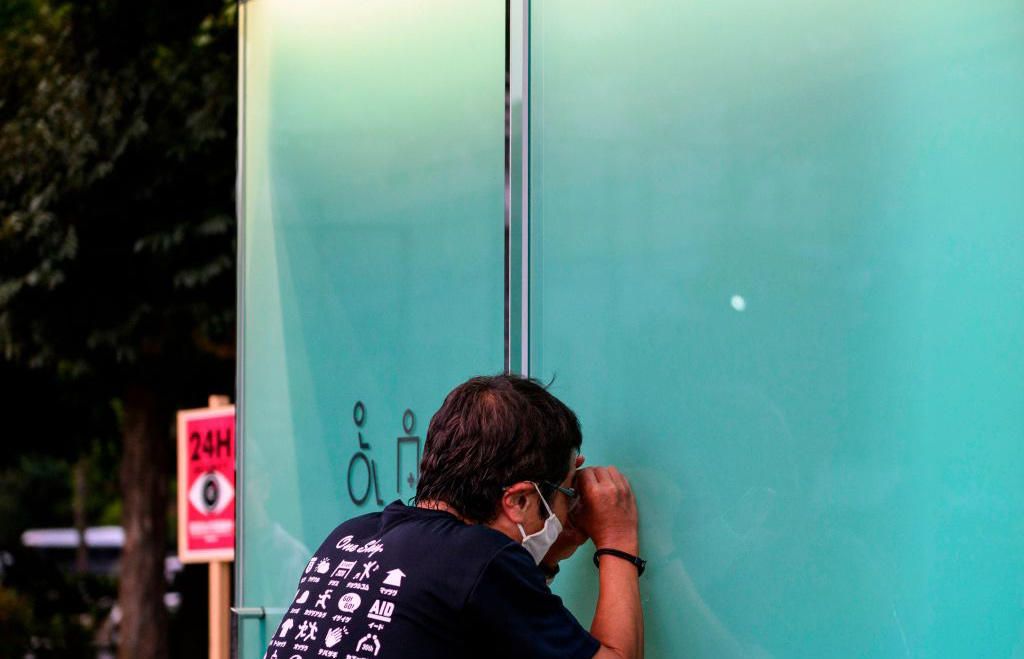東京街頭的透明公共廁所,你敢用嗎?

曾經(jīng)獲得普利茲克獎(jiǎng)的日本建筑師坂茂(Shigeru Ban)在業(yè)界已經(jīng)小有名氣,他主要設(shè)計(jì)游客中心、博物館、公寓和時(shí)尚風(fēng)格的私人住宅。此外,他還為地震、洪水和戰(zhàn)爭設(shè)計(jì)應(yīng)急避難所。今年,為了配合已經(jīng)被推遲的東京奧運(yùn)會(huì),受一家日本基金會(huì)的委托,坂茂參與了東京公共廁所群的建造——聽起來有些大材小用,但請接著往下看。
這一賽事的結(jié)果于8月5日在澀谷區(qū)Yoyogi公園附近的兩個(gè)地點(diǎn)公布,同時(shí)也吸引了全球的關(guān)注。原因在于坂茂設(shè)計(jì)的洗手間是燈火通明的彩色玻璃盒子,完全透明,或者至少一開始看起來是這樣。這些建筑是由“智能玻璃”制成的,當(dāng)使用者進(jìn)入并鎖上門后,這些玻璃會(huì)變得不透明。
坂茂稱這些建筑為“Tomei廁所”(Tomei在日語中是“透明”的意思)。在他看來,這個(gè)設(shè)計(jì)解答了人人都會(huì)在上公共廁所時(shí)擔(dān)心的問題:廁所干凈嗎?是不是已經(jīng)有人在里面了?
到了晚上,廁所設(shè)施會(huì)像“一盞美麗的燈籠”一樣散發(fā)著光亮。

坂茂設(shè)計(jì)的發(fā)光廁所是“東京廁所項(xiàng)目”(Tokyo Toilet Project)的一部分,該項(xiàng)目位于涉谷,由17個(gè)公共廁所組成,由日本基金會(huì)(Nippon Foundation)委托設(shè)計(jì)。日本基金會(huì)是摩托艇賽巨頭笹川良一(Ryoichi Sasakawa)創(chuàng)立的慈善組織。參與這項(xiàng)工作的其他設(shè)計(jì)者也都是日本建筑界和設(shè)計(jì)界的佼佼者:安藤忠雄、藤本壯介、伊東豐雄、片山正通、隈研吾、槙文彥、田村奈惠和佐藤可士和。
大家都知道日本人注重清潔和個(gè)人衛(wèi)生。《衛(wèi)報(bào)》(Guardian)的賈斯汀?麥柯里指出,日本的高科技廁所長期以來一直吸引著外國游客,但有時(shí)也讓游客們摸不著頭腦。在新冠肺炎疫情爆發(fā)之前,日本最大的馬桶生產(chǎn)商Toto公司生產(chǎn)的高檔衛(wèi)浴產(chǎn)品,幾乎是中國游客赴日旅游時(shí)的“必購之物”。
但這次,將為涉谷新廁所的設(shè)施維護(hù)買單的日本基金會(huì)表示,他們希望消除公眾對公廁“黑暗、骯臟、難聞”的誤解。基金會(huì)稱其目標(biāo)是利用先進(jìn)的設(shè)計(jì)創(chuàng)造出“無論性別、年齡、是否殘疾,人人都可以使用的公共廁所”。他們想借此闡釋:包容性社會(huì)的達(dá)成,是有可能的。
當(dāng)然,在藝術(shù)方面,這些廁所也能夠讓游客感到極度舒適。安藤忠雄為Jingu Dori公園設(shè)計(jì)的廁所,帶有一個(gè)傾斜屋頂?shù)膱A形結(jié)構(gòu),可以作為咖啡館或奢侈品精品店使用。槙文彥為East Ebisu公園設(shè)計(jì)的廁所則帶有一個(gè)室內(nèi)庭院和造型優(yōu)美的弧形白色屋頂,看起來就像是一個(gè)藝術(shù)畫廊。
把這樣的創(chuàng)造力“浪費(fèi)”在馬桶和廁所上,有意義嗎?也許確實(shí)沒有什么意義。但是,公共廁所從人類文明開始就一直是人們設(shè)計(jì)的焦點(diǎn)——從某種意義上說,廁所是文明社會(huì)的標(biāo)志之一。提供一個(gè)有趣的事實(shí):已知最早的復(fù)雜污水系統(tǒng)連接多個(gè)抽水馬桶的例子,出現(xiàn)在印度河流域的哈拉帕和摩亨佐-達(dá)羅古城,可以追溯至公元前3世紀(jì)中期。而將巧妙、偉大的設(shè)計(jì)應(yīng)用到這樣一種最日常的人類需求中,何嘗不是一種眾生平等的體現(xiàn)呢?
(說回東京的透明廁所吧。)到目前為止,其中的7座廁所已經(jīng)建成,剩下的10座預(yù)計(jì)將在未來幾個(gè)月內(nèi)開放。(財(cái)富中文網(wǎng))
編譯:楊二一
曾經(jīng)獲得普利茲克獎(jiǎng)的日本建筑師坂茂(Shigeru Ban)在業(yè)界已經(jīng)小有名氣,他主要設(shè)計(jì)游客中心、博物館、公寓和時(shí)尚風(fēng)格的私人住宅。此外,他還為地震、洪水和戰(zhàn)爭設(shè)計(jì)應(yīng)急避難所。今年,為了配合已經(jīng)被推遲的東京奧運(yùn)會(huì),受一家日本基金會(huì)的委托,坂茂參與了東京公共廁所群的建造——聽起來有些大材小用,但請接著往下看。
這一賽事的結(jié)果于8月5日在澀谷區(qū)Yoyogi公園附近的兩個(gè)地點(diǎn)公布,同時(shí)也吸引了全球的關(guān)注。原因在于坂茂設(shè)計(jì)的洗手間是燈火通明的彩色玻璃盒子,完全透明,或者至少一開始看起來是這樣。這些建筑是由“智能玻璃”制成的,當(dāng)使用者進(jìn)入并鎖上門后,這些玻璃會(huì)變得不透明。
坂茂稱這些建筑為“Tomei廁所”(Tomei在日語中是“透明”的意思)。在他看來,這個(gè)設(shè)計(jì)解答了人人都會(huì)在上公共廁所時(shí)擔(dān)心的問題:廁所干凈嗎?是不是已經(jīng)有人在里面了?
到了晚上,廁所設(shè)施會(huì)像“一盞美麗的燈籠”一樣散發(fā)著光亮。
坂茂設(shè)計(jì)的發(fā)光廁所是“東京廁所項(xiàng)目”(Tokyo Toilet Project)的一部分,該項(xiàng)目位于涉谷,由17個(gè)公共廁所組成,由日本基金會(huì)(Nippon Foundation)委托設(shè)計(jì)。日本基金會(huì)是摩托艇賽巨頭笹川良一(Ryoichi Sasakawa)創(chuàng)立的慈善組織。參與這項(xiàng)工作的其他設(shè)計(jì)者也都是日本建筑界和設(shè)計(jì)界的佼佼者:安藤忠雄、藤本壯介、伊東豐雄、片山正通、隈研吾、槙文彥、田村奈惠和佐藤可士和。
大家都知道日本人注重清潔和個(gè)人衛(wèi)生。《衛(wèi)報(bào)》(Guardian)的賈斯汀?麥柯里指出,日本的高科技廁所長期以來一直吸引著外國游客,但有時(shí)也讓游客們摸不著頭腦。在新冠肺炎疫情爆發(fā)之前,日本最大的馬桶生產(chǎn)商Toto公司生產(chǎn)的高檔衛(wèi)浴產(chǎn)品,幾乎是中國游客赴日旅游時(shí)的“必購之物”。
但這次,將為涉谷新廁所的設(shè)施維護(hù)買單的日本基金會(huì)表示,他們希望消除公眾對公廁“黑暗、骯臟、難聞”的誤解。基金會(huì)稱其目標(biāo)是利用先進(jìn)的設(shè)計(jì)創(chuàng)造出“無論性別、年齡、是否殘疾,人人都可以使用的公共廁所”。他們想借此闡釋:包容性社會(huì)的達(dá)成,是有可能的。
當(dāng)然,在藝術(shù)方面,這些廁所也能夠讓游客感到極度舒適。安藤忠雄為Jingu Dori公園設(shè)計(jì)的廁所,帶有一個(gè)傾斜屋頂?shù)膱A形結(jié)構(gòu),可以作為咖啡館或奢侈品精品店使用。槙文彥為East Ebisu公園設(shè)計(jì)的廁所則帶有一個(gè)室內(nèi)庭院和造型優(yōu)美的弧形白色屋頂,看起來就像是一個(gè)藝術(shù)畫廊。
把這樣的創(chuàng)造力“浪費(fèi)”在馬桶和廁所上,有意義嗎?也許確實(shí)沒有什么意義。但是,公共廁所從人類文明開始就一直是人們設(shè)計(jì)的焦點(diǎn)——從某種意義上說,廁所是文明社會(huì)的標(biāo)志之一。提供一個(gè)有趣的事實(shí):已知最早的復(fù)雜污水系統(tǒng)連接多個(gè)抽水馬桶的例子,出現(xiàn)在印度河流域的哈拉帕和摩亨佐-達(dá)羅古城,可以追溯至公元前3世紀(jì)中期。而將巧妙、偉大的設(shè)計(jì)應(yīng)用到這樣一種最日常的人類需求中,何嘗不是一種眾生平等的體現(xiàn)呢?
(說回東京的透明廁所吧。)到目前為止,其中的7座廁所已經(jīng)建成,剩下的10座預(yù)計(jì)將在未來幾個(gè)月內(nèi)開放。(財(cái)富中文網(wǎng))
編譯:楊二一
Shigeru Ban, the Pritzker Prize-winning Japanese architect, is renowned as a designer of visitor centers, museums, condominiums, and stylish private residences. He also is acclaimed for his work as a designer of emergency shelters for victims of earthquakes, floods, and war. This year, in conjunction with the now-postponed Tokyo Olympic Games, a Japanese foundation commissioned Ban to apply his prodigious talents to the creation of a lowlier structure: public toilets.
The result, unveiled August 5 in two locations near Shibuya ward's Yoyogi Park, is attracting global attention. The reason? Ban's restrooms are brightly lit boxes of colored glass—and completely transparent. Or at least they seem to be at first. The structures are fashioned from "smart glass" that renders them opaque after a user enters and locks the door.
Ban calls these structures "tomei toilets." (Tomei is the Japanese word for "see-through.") He says the design presented itself to him as the obvious solution to two questions everyone worries about when using a public toilet: Is it clean? And is it already occupied?
At night, the facilities radiate light "like a beautiful lantern."
Ban's glowing boxes are part of the "Tokyo Toilet Project," a series of 17 public toilets in Shibuya commissioned for redesign by the Nippon Foundation, the philanthropic organization founded by motorboat racing kingpin Ryoichi Sasakawa. Other creators enlisted in the effort include some of the biggest names in the world of Japanese architecture and design: Tadao Ando, Sou Fujimoto, Toyo Ito, Masamichi Katayama, Kengo Kuma, Fumihiko Maki, Nao Tamura, and Kashiwa Sato.
Modern Japan is famed for its attention to cleanliness and personal hygiene. And as the Guardian's Justin McCurry's notes, Japan's high-tech toilets have long fascinated—and perplexed—foreign visitors. Before the pandemic struck, luxury washlets made by Japan's largest toilet maker, Toto Ltd., were a prized purchase for Chinese tourists visiting Japan.
But the Nippon Foundation, which also will pay to maintain the new facilities, says it wants to dispel misconceptions that public toilets are "dark, dirty, smelly, and scary." The Foundation describes its goal as using advanced design to create structures that will be "accessible for everyone regardless of gender, age, or disability, to demonstrate the possibilities of an inclusive society."
Certainly, visitors will be able to relieve themselves in style. The toilet designed by Tadao Ando for Jingu Dori Park is a circular structure with a tilted engawa roof that could pass for a cafe or a luxury boutique. Maki's toilet in East Ebisu Park features an interior courtyard and graceful curved, white roof that looks almost as if it houses an art gallery.
Does it make sense to lavish this kind of creativity on a commode? Perhaps not. But public toilets have been a focus of human design efforts since the beginning of civilization, and in a sense, are one of the hallmarks of a civilized society. (Fun fact: The earliest known example of multiple flushing lavatories attached to a sophisticated sewage system were in the ancient cities of Harappa and Mohenjo-Daro in Indus Valley, dating from the mid-3rd millennium BC.) And there is something wonderfully democratic about applying design to such an everyday human necessity.
Seven of the structures have been built so far, with the remaining ten expected to open in coming months.













